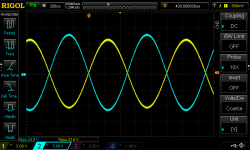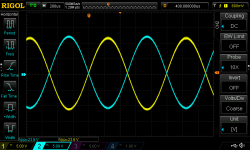Quick update on this. First, I checked the voltage dropped over what I'm going to call the series bias diodes for each channel. They were within a few millivolts of each other even when the channel with the higher bias current was starting to go into thermal runaway. The only way I could get them to show more discrepancy between the two channels was when I intentionally heated one side with the hot air station.
What I think is more interesting is that when I shorted one of the three series diodes, that problem channel drops to almost no bias current (less than 1 hundredth of a millivolts, which is probably noise floor for my meter) and the channel ceases to be a problem no matter how much I locally heat that channel with hot air. Given enough time with the previous higher channel under control, the channel which starts off lower starts to go into thermal runaway again. Shorting one diode in that series chain fixed that one as well.
If I'm understanding correctly and these are class b amps, then there should be no bias current and the drive circuit is just designed to be fast enough to drive the outputs into conduction without any crossover distortion. I haven't scoped the outputs yet, but provided there is no evidence of crossover distortion, is there any harm in leaving it with one shorted diode in the chain?
The previous owner subbed in some on-semi outputs that I've never seen before. On paper they are not a bad replacement for the Motorola/Toshiba parts. I know that transistor replacements in an ab amp often require bias adjustment even if you use the same as stock parts. I'm wondering if there subbed transistors might be the root cause got these bias issues.
Thank you,
Jason
What I think is more interesting is that when I shorted one of the three series diodes, that problem channel drops to almost no bias current (less than 1 hundredth of a millivolts, which is probably noise floor for my meter) and the channel ceases to be a problem no matter how much I locally heat that channel with hot air. Given enough time with the previous higher channel under control, the channel which starts off lower starts to go into thermal runaway again. Shorting one diode in that series chain fixed that one as well.
If I'm understanding correctly and these are class b amps, then there should be no bias current and the drive circuit is just designed to be fast enough to drive the outputs into conduction without any crossover distortion. I haven't scoped the outputs yet, but provided there is no evidence of crossover distortion, is there any harm in leaving it with one shorted diode in the chain?
The previous owner subbed in some on-semi outputs that I've never seen before. On paper they are not a bad replacement for the Motorola/Toshiba parts. I know that transistor replacements in an ab amp often require bias adjustment even if you use the same as stock parts. I'm wondering if there subbed transistors might be the root cause got these bias issues.
Thank you,
Jason
I don't think it would hurt to have one diode bypassed. Confirm that it's not causing any significant DC offset. The op-amp should be compensating easily.
It's possible that the difference in outputs has changed the bias requirements. Transistors often change a bit as manufacturing changes.
On-semi is a spin-off from motorola.
Did the drivers cool any when the bias was reduced?
It's possible that the difference in outputs has changed the bias requirements. Transistors often change a bit as manufacturing changes.
On-semi is a spin-off from motorola.
Did the drivers cool any when the bias was reduced?
Yes, they were significantly cooler, and so is one of the two power supply transformers. I'm going to get back to those in a while, but I think maybe the one that still is getting hot may have a leaking rectifier. I was trying to avoid pulling the rectifiers got testing because they are in a horrible place (sandwiched between the board and sink but directly under the transformers), so I'll probably have to remove the transformer to be able to properly desolder the rectifiers.
This may or may not work but if you want to leave all of the diodes in the circuit, you could try relocating one to the back of the driver so it heats with the driver to reduce the bias current.
Ok folks, I'm hoping this is the last installment to my questions about these amplifiers.
I'm satisfied that the changes made to the bias circuit have fixed the thermal runaway issues. The drivers are running much cooler, but i put clip on sinks on them anyhow.
I was buttoning up the second one and getting ready for burn-in when i noticed that the two channels are not perfectly level matched in stereo. I've been through the pre-amp with a fine tooth comb. I hopped it was a dirty pot, but no such luck. I've installed fixed resistors with no change in behavior. I've replaced all the wet caps in the audio path and meter checked every single resistor. Any odd readings and i lifted a leg and rechecked. All are in spec. The input signals are within a few millivolts of each other until the inverting op-amp. At the output of the inverting op-amp the left channel is about 200mV lower than the right. By the time it goes through the poweramp there is a bit more than 2v difference vpp. It's not much, but it's triggered my OCD and I've now dug in for two days straight trying to find the cause.
One of the first things I did was pull the muting JFETS. They tested fine, and the problem was still there with them out of circuit. I have also replaced both the gain op-amp as well as the inverting op-amp.
The clincher on this whole deal-- when the amp is in "mono" mode with the inputs summed the channels are dead nuts equal. Attached are screenshots of the scope. 1kHz function generator, both channels driven separately. The first shows the out of balance channels. The second shows the amp in mono mode.
I think its unlikely to be audible, but at this point I really want to know what is causing it.
Thanks,
Jason
I'm satisfied that the changes made to the bias circuit have fixed the thermal runaway issues. The drivers are running much cooler, but i put clip on sinks on them anyhow.
I was buttoning up the second one and getting ready for burn-in when i noticed that the two channels are not perfectly level matched in stereo. I've been through the pre-amp with a fine tooth comb. I hopped it was a dirty pot, but no such luck. I've installed fixed resistors with no change in behavior. I've replaced all the wet caps in the audio path and meter checked every single resistor. Any odd readings and i lifted a leg and rechecked. All are in spec. The input signals are within a few millivolts of each other until the inverting op-amp. At the output of the inverting op-amp the left channel is about 200mV lower than the right. By the time it goes through the poweramp there is a bit more than 2v difference vpp. It's not much, but it's triggered my OCD and I've now dug in for two days straight trying to find the cause.
One of the first things I did was pull the muting JFETS. They tested fine, and the problem was still there with them out of circuit. I have also replaced both the gain op-amp as well as the inverting op-amp.
The clincher on this whole deal-- when the amp is in "mono" mode with the inputs summed the channels are dead nuts equal. Attached are screenshots of the scope. 1kHz function generator, both channels driven separately. The first shows the out of balance channels. The second shows the amp in mono mode.
I think its unlikely to be audible, but at this point I really want to know what is causing it.
Thanks,
Jason
Attachments
Did you use a multimeter and measure both channels from the RCA input to the output to see where the difference came in?
Did you try swapping the inputs since they were not precisely the same?
If there are EQs or Crossovers, are they all set to flat/full range?
Did you try swapping the inputs since they were not precisely the same?
If there are EQs or Crossovers, are they all set to flat/full range?
I'm not entirely sure I understand the first question. Multimeter from RCA input to poweramp output? If that's what you meant, no I didn't do that.
I did swap inputs, there was no difference, the issue stays with the left channel. I also drove the amp with the balanced inputs instead of the single ended inputs on the din connector. It behaved the same way with balanced signal.
There is no eq or crossover in the amp and I'm driving it from an arbitrary function generator, so nothing hinky with the source.
The signal does not get out of balance by any significant amount until the op-amp that inverts the left channel for bringing. The left signal drivers the inverting input of an op-amp while the right channel drives the non inverting input of the other channel of the op-amp. The left signal goes through a 10k series resistor, while the right goes through a 1k series resistor. I'm thinking this might be where the slight imbalance comes from, but since the op-amp requires very little current to drive, I'm kind of surprised that the series resistor could cause this difference. I may just experiment with the values a bit, but I was hoping someone more familiar with these old Orions would have seen this before...
Thank you for your help!
Sincerely,
Jason
I did swap inputs, there was no difference, the issue stays with the left channel. I also drove the amp with the balanced inputs instead of the single ended inputs on the din connector. It behaved the same way with balanced signal.
There is no eq or crossover in the amp and I'm driving it from an arbitrary function generator, so nothing hinky with the source.
The signal does not get out of balance by any significant amount until the op-amp that inverts the left channel for bringing. The left signal drivers the inverting input of an op-amp while the right channel drives the non inverting input of the other channel of the op-amp. The left signal goes through a 10k series resistor, while the right goes through a 1k series resistor. I'm thinking this might be where the slight imbalance comes from, but since the op-amp requires very little current to drive, I'm kind of surprised that the series resistor could cause this difference. I may just experiment with the values a bit, but I was hoping someone more familiar with these old Orions would have seen this before...
Thank you for your help!
Sincerely,
Jason
Start at the RCAs and calculate the difference in dB. Do this at every stage to see where it changes the most from channel to channel.
- Status
- Not open for further replies.
- Home
- General Interest
- Car Audio
- Orion XTR 200 hot transformers

